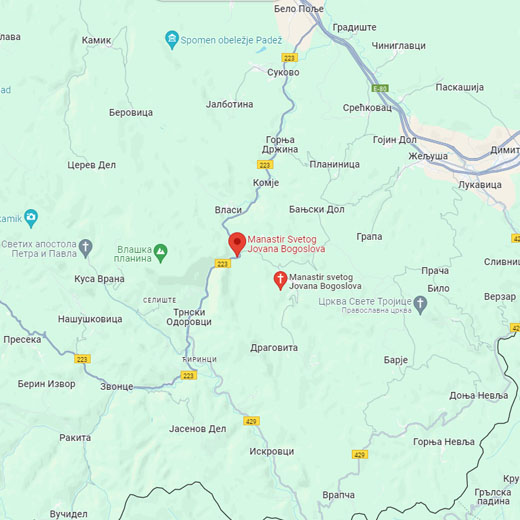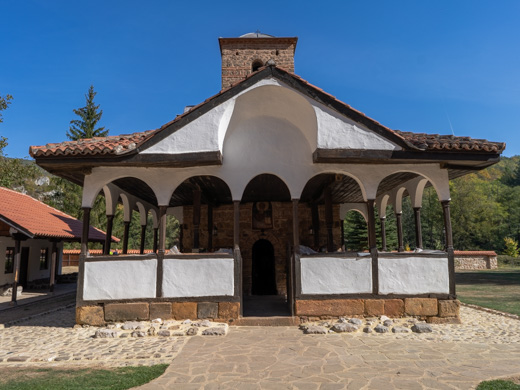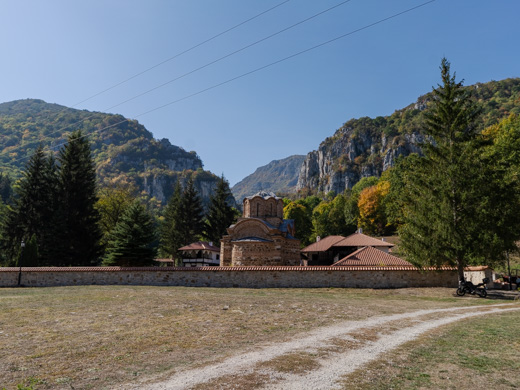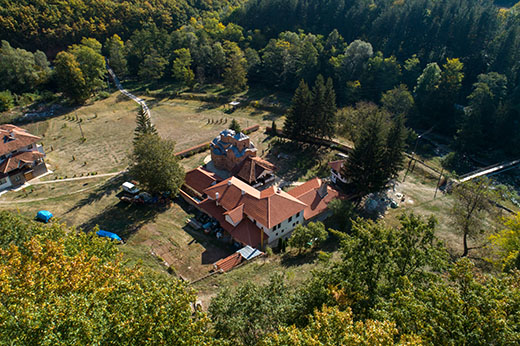Poganovo Monastery
Protected cultural monument of great significance, listed under SK 222 in the Central registry of the Republic Institute for the protection of cultural monuments
Poganovo Monastery, Dimitrovgrad municipality, Pirot administrative county
Where is it located?
Poganovo Monastery was built in the picturesque canyon of the river Jerma between Odrovac and Vlaška gorge, on the left bank, near the village of Poganovo. It is located in the municipality of Dimitrovgrad, 15 km south of Pirot.

History
Monastery in the Poganovo village was founded by Serbian nobleman Konstantin Dejanović Dragaš, nephew of Emperor Dušan, as his endowment. After he died in the Rovine battle, the building of the monastery was continued by his daughter Helena, who was married to the Byzantine emperor Manuel II Palaiologos. The history of the monastery is written in three stones built in the western wall of the temple; the inscription mentions the patron John the Theologian, Lord Constantine and Lady Helena. Another interpretation says that the monastery was built later, between 1413 and 1425, at the time of Stefan Lazarević, as the endowment of Konstantin, the son of great duke Desimir.
The iconography was done a century later, in 1499. The name of the painter remains unknown.
 As the temple was build in the canyon and was not very accessible, it was not devastated during the Turkish reign. That is why it preserved its original form, and it was only renewed in 1876, when the open porch was added.
As the temple was build in the canyon and was not very accessible, it was not devastated during the Turkish reign. That is why it preserved its original form, and it was only renewed in 1876, when the open porch was added.
The impassable canyon did not have any roads until 1927. Several years later, in 1930, the Mining and Roadwork Enterprise Jerma donated a large bell to the monastery, for which a bell tower was built.

During the First World War the Bulgarians ravaged the monastery and took the iconostasis from 1620 and the miraculous icon of Holy Mother which is now kept in the Ecclesiastical museum in Sofia. The miraculous, double-sided icon represents the miracle of Latomos on one side, and the characters of Holy Mother and St. John the Theologian on the other. The icon was a gift to the monastery by Empress Helena, wife of the Byzantine emperor Manuel II Palaiologis, in memory of her father Constantine Dejan.

Description
Monastery church, temple dedicated to St. John the Theologian, is in its base a condensed trichonostas with seven-sided arched vestibule. Above the narthex there is a second storey with a bell tower above, functioning as a watchtower. The church is small, single-nave with two lateral apses, belonging to the Morava building school but also representing the continuation of Serbian medieval building and Byzantine heritage.
The church was built using local crushed stone, sandstone and lime, bound with lime mortar and decorated by bricks. The facade distinguishes three stone-made zones divided by two rows of stone bordered with bricks, which is a unique decoration on the otherwise simple facade. The upper parts of the edifice are made from decorative stone blocks, with surface in shallow relief.
The roof of the church was originally tiled, but after the restoration it was covered with tin.
There aren't many secondary decorations on the facade, which is rare for the monuments of the Morava school.
The iconography was done in 1499 by the artists from the northern Greece. It represents some of the highest artistic achievements of its time in the Balkans. It contains the compositions of Great holidays, teachings of holy fathers, scenes from Holy Mary's life, Christ’s suffering, as well as the representations of Serbian holy figures, Balkan anchorites and apostles, illustrating the cults of saints.
The iconography made in 1620 was high, carved in wood and gilded. During the First World War, the Bulgarians took it down and took to Sofia, along with many other treasures. Today's iconostas was made in the second half of 19th century.

Dating
End of the 14th and the beginning of 15th century.
Folk lore, legends
After their conquest, the Turks renamed the village originally called Dobroševo into Poganovo. The unusual name remains to this day. Although the competent ministry returned the name in 1934, and the official documents referred to the monastery as „Dobroševski“, the local people continued to call it Poganovski / Poganovo.Folk tradition says that the monastery was founded by Holy Emperor Constantine and his mother Helen.
Archpriest Theodor Titov claims that the old parchment inscription states that the Serbs built this monastery prior to 1130. However, the newer historiography dates the monastery into late 14th or early 15th century.
Јулка Кузмановић Цветковићархеолошкиња
